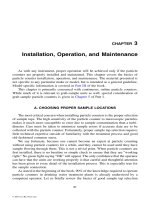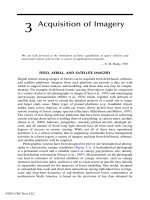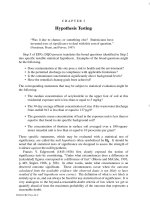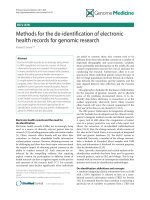Lecture Electronic health records for allied health careers: Chapter 3 - Susan Sanderson
Bạn đang xem bản rút gọn của tài liệu. Xem và tải ngay bản đầy đủ của tài liệu tại đây (328.34 KB, 10 trang )
Cover goes here when ready
Electronic Health
Records for Allied
Health Careers
Chapter 3
Electronic Health
Records in the
Physician Office
McGrawHill
Copyright © 2009 by The McGrawHill Companies, Inc. All Rights Reserved.
3-2
Learning Outcomes
After studying this chapter, you should be able to:
1. List the five steps of the office visit workflow in a
physician office.
2. Discuss the advantages of pre-visit scheduling and
information collection for patients and office staff.
3. Describe the process of electronic check-in.
4. Explain how electronic health records make documenting
patient exams more efficient.
5. Explain what occurs during patient checkout.
3-3
Learning Outcomes
After studying this chapter, you should be able to:
6. Explain what two events take place during the post-visit
step of the visit workflow.
7. Describe the advantages of computer-assisted coding.
8. List three decision-support tools the EHRs contain to
provide patients with safe and effective health care.
9. List four important safety checks that an EHR’s
e-prescribing feature can perform when a physician
selects a new medication for a patient.
3-4
Key Terms
•
•
•
•
•
chronic diseases
clinical guidelines
computer-assisted coding
decision-support tools
disease management
(DM)
• formulary
• point-of-care
3-5
Patient Flow
• progression of patients from the time they make
an appointment until they leave the office after a
visit. Whether paper-based or electronic health
records are used, the basic steps are the same.
3-6
Patient Flow Steps
• Step 1: Pre-Visit: Appointment Scheduling and
Information Collection
• Step 2: Patient Check-in and Payment Collection
• Step 3: Rooming, Measuring Vital Signs, and
Patient Examination and Documentation
• Step 4: Patient Checkout
• Step 5: Post-Visit: Coding and Billing, and
Reviewing Test Results
3-7
Coding and Reimbursement
• Documentation and coding plays a major role in
whether a payer approves claims and reimburses
the physician.
• Computer-assisted coding uses software to
facilitate claim processing.
3-8
Clinical Tools in the EHR
•
•
•
•
•
•
Decision-Support Tools
Tracking and Monitoring Patient Care
Screening for Illness and Disease
Identifying At-Risk Patients
Managing Patients with Chronic Diseases
Improving the Quality and Safety of Patient Care
with Evidence-Based Clinical Guidelines
3-9
E-Prescribing
• Institute of Medicine recommends the use of
e-prescriptions by all providers and pharmacies by
2010.
• Keeping Current with Electronic Drug Databases
3-10
E-Prescribing Benefits
Increasing Prescription Safety
• Drug-Allergy Conflict
• Drug-Disease Conflict
• Incorrect Dosage
• Incorrect Duration
• Drug-Pregnancy Conflict
• Drug-Age Conflict
• Drug-Gender Conflict
• Drug-Drug Interactions
Saving Time and Money









